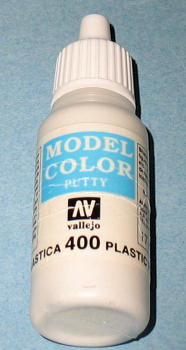How To Use Vallejo Plastic Putty
 Vallejo Plastic Putty was something I was introduced to by my Local Hobby Shop Possessor when I asked near an like shooting fish in a barrel to use filler that didn�t use lacquer thinner. Curious, I bought a bottle and used it for several of my recent kits to gauge its usefulness.
Vallejo Plastic Putty was something I was introduced to by my Local Hobby Shop Possessor when I asked near an like shooting fish in a barrel to use filler that didn�t use lacquer thinner. Curious, I bought a bottle and used it for several of my recent kits to gauge its usefulness.
This white putty comes in the aforementioned 17 ml plastic squeeze bottle as Vallejo pigment which makes information technology easy to squeeze out the amount you lot need. The putty itself is similar in consistency equally plaster (a little thicker than Mr Surfacer 500) but you can use rubbing alcohol to thin information technology a chip and can exist applied the same as whatever other putty. It dries pretty fast (10-15 minutes) but it does not fully cure for a ane to three days which ways that it is withal pretty soft and can not be vigorously sanded.
I found that it tin can not be vigorously sanded fifty-fifty fully cured because of its acrylic nature. Even wet sanding, the putty residuum clogs up sand paper very rapidly and information technology every bit the annoying addiction of coming off in clumps or peel away like dried up latex paint due to acrylic�s weak grip on plastic surfaces.
It supposedly polishes well (for Virtually Metallic Cease) but I�d still recommend using primer due to the fact that information technology volition be a lighter color compared to the plastic and volition prove thru on thin paints such every bit metallics, reds, yellows, light greens and low-cal blues.
Despite this, I plant Vallejo Acrylic Putty useful for sink marks and filling in other types of surface imperfections. I would fill up the depression with Vallejo Putty, permit it dry and so cover information technology with a thin layer of CA glue. Once the CA glue dried then I would sand it smoothen without too much trouble. Much easier than using multiple layers of CA glue (my usual method) and easier to sand than multiple hardened layers of CA glue. I think it would be ideal to utilise for resin pinholes without too much sanding (there was a recent Fine Scale Models article on building a Resin Car that highlighted use of this putty.)
I was hoping to dump my Mr Surfacer, simply it appears I still need it although not as much equally I did in the past. Vallejo Acrylic Putty is rather useful for filling those abrasive modest gaps between parts, sink marks/pinholes (in conjunction with CA glue) , great for gaps between figures (which is what I doubtable that this stuff was originally designed for) considering it tin be easily molded and for those annoying phantom seams that sometimes announced later sanding and filling.
Pros
- acrylic based (no lacquer thinner)
- piece of cake to use
- doesn�t shrink or shrinks very picayune compared to lacquer based putties
- keen for small-scale areas and surface depressions
- easy to make clean with booze and/or water
- surface dries fast
- easy to mold
- cracking for figures
Cons
- acrylic based (doesn�t grip well to plastic)
- not good for any gap greater than 1mm
- not a 100% replacement for Mr Surfacer
- reacts with acrylic paint
- cures slowly
December 2008
How To Use Vallejo Plastic Putty,
Source: https://modelingmadness.com/others/detailsets/leeputty.htm
Posted by: sosaammed1971.blogspot.com


0 Response to "How To Use Vallejo Plastic Putty"
Post a Comment